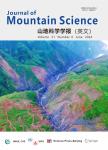Spatial-temporal variability of throughfall in a subtropical deciduous forest from the hilly regions of eastern China
Spatial-temporal variability of throughfall in a subtropical deciduous forest from the hilly regions of eastern China作者机构:Key Laboratory of Watershed Geographic SciencesNanjing Institute of Geography and LimnologyChinese Academy of SciencesNanjing 210008China University of Chinese Academy of SciencesBeijing 100049China Chuzhou Hydrology LaboratoryNanjing Hydraulic Research InstitutesNanjing 210029China Tourism SchoolJiujiang CollegeJiujiang 332005China State Key Laboratory of Desert and Oasis EcologyXinjiang Institute of Ecology and GeographyChinese Academy of SciencesUrumqi 830011China
出 版 物:《Journal of Mountain Science》 (山地科学学报(英文))
年 卷 期:2019年第16卷第8期
页 面:1788-1801页
核心收录:
学科分类:09[农学] 0903[农学-农业资源与环境]
基 金:supported by the National Natural Science Foundation of China (Grants No. 41861022, 91647203, 51609145) the Natural Science Foundation of Jiangsu Province (No. BK20161612) “One-Three-Five” Strategic Planning of Nanjing Institute of Geography and Limnology, Chinese Academy of Sciences (Grant No. NIGLAS2017GH07) Science Foundation of Nanjing Hydraulic Research Institute (No. Y517009) Jiangsu Planned Projects for Postdoctoral Research Funds (118000003)
主 题:Throughfall variability Spatial heterogeneity Temporal stability Meteorological variables Canopy structure Subtropical forest
摘 要:Throughfall variability plays a crucial role in regulating hydrological and biogeochemical processes in forest ecosystems. However, throughfall variability and its potential influencing factors remain unclear in the subtropical deciduous forest because of its complex canopy and meteorological conditions. Here, the spatial variability and temporal stability of throughfall were investigated from October 2016 to December 2017 within a deciduous forest in the subtropical hilly regions of eastern China, and the effects of meteorological variables and distance from nearest tree trunk on throughfall variability were systematically evaluated. Throughfall variability during the leafed period was slightly higher than that during the leafless period inferred from the coefficient of variation of throughfall amounts(CVTF), with 13.2%-40.9% and 18.7%-31.9%, respectively. The multiple regression model analysis suggested that the controlling factors of throughfall variability were different in studied periods: Maximum 10-min rainfall intensity, wind speed and air temperature were the dominant influencing factors on throughfall variability during the leafed period, with the relative contribution ratio(RCR) of 25.9%, 18.7% and 8.9%, respectively. By contrast, throughfall variability was affected mainly by the mean rainfall intensity(RCR=40.8%) during the leafless period. The temporal stability plots and geostatistical analysis indicated that spatial patterns of throughfall were stable and similar among rainfall events. Our findings highlight the important role of various meteorological factors in throughfall variability and are expected to contribute to the accurate assessment of throughfall, soil water and runoff within the subtropical forests.



